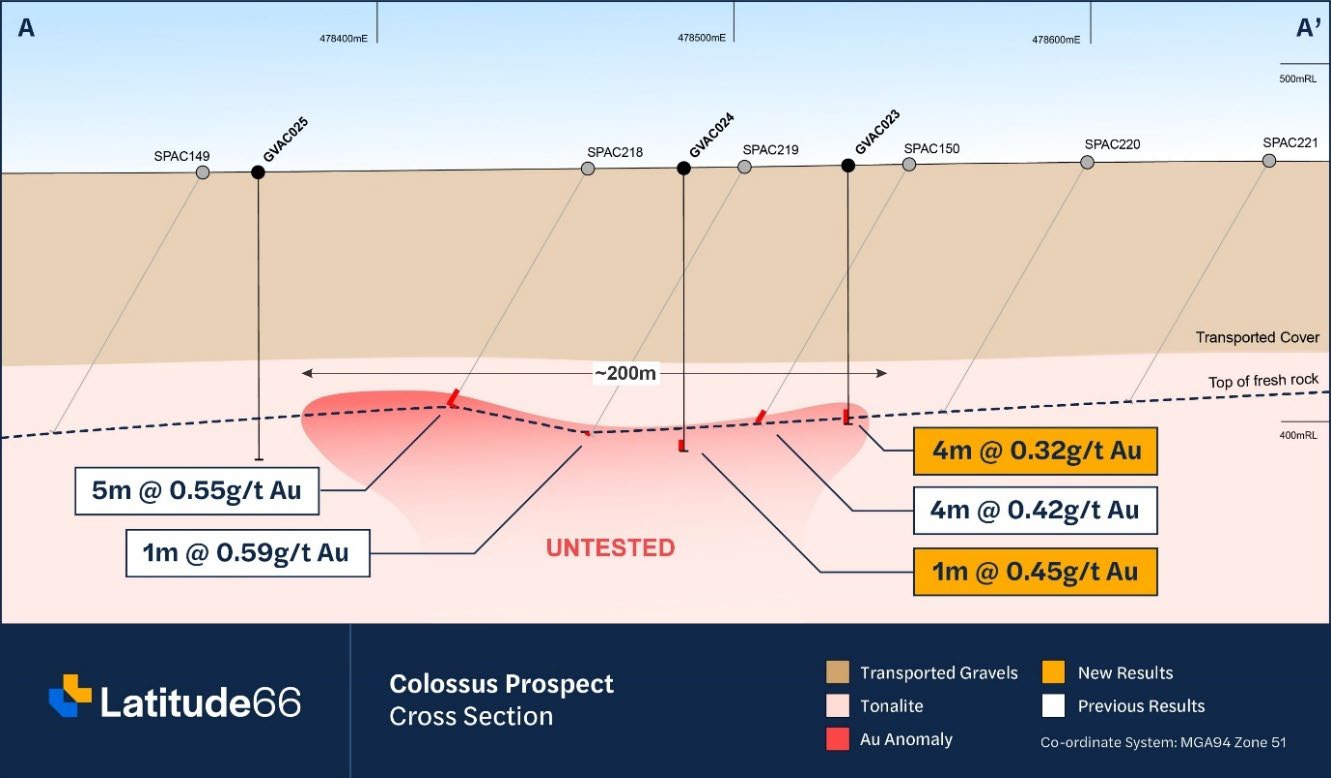Latitude 66 Strikes Gold (Again) at Edjudina’s Colossus Prospect
7/8/2025
Latitude 66 (ASX:LAT) is living up to its name with a golden run of exploration success at its Edjudina Project in Western Australia, reporting fresh drill results that firm up a potentially significant gold system at the aptly named Colossus prospect.

The company has released assays from the first 36 holes of an 88-hole aircore campaign targeting surface gold anomalies—results which suggest the Colossus target may be more than just a shiny distraction in the desert sands. The assays confirm a coherent zone of bottom-of-hole gold mineralisation associated with promising alteration minerals, suggesting a nearby, as-yet-unrevealed primary gold source lurks just beneath the weathered surface.
Among the better intercepts from this early batch:
1 metre at 0.45 grams per tonne (g/t) gold from 78 metres in hole GVAC024
4 metres at 0.32 g/t from 68 metres in GVAC023
These new results echo previous intercepts, including:
5 metres at 0.55 g/t from 72 metres (SPAC218)
4 metres at 0.42 g/t from 80 metres (SPAC150)
1 metre at 0.59 g/t from 86 metres (SPAC219)
Taken together, they delineate a 200-metre-wide and 400-metre-long corridor of mineralisation, hosted in granitoid rocks, where end-of-hole assays are brushing against what looks like a system with deeper roots.
Managing Director Grant Coyle was upbeat, stating, “These initial results from Colossus are highly encouraging and reinforce our belief in the potential of the Edjudina Project to host a significant gold deposit.” He added that the geological setting—especially the combination of silica-hematite alteration and quartz veining—suggests that “we are vectoring in on a primary source of gold mineralisation that remains open at depth.”
Geologically speaking, Colossus is shaping up as a cousin to Ramelius Resources’ Lake Rebecca Project some 75 kilometres to the south. Both feature mineralisation within deformed felsic intrusives and high-strain granitic gneiss, underpinned by hydrothermal alteration and sulphides. In the case of Colossus, that translates to strong silica and hematite alteration at the base of weathering, hinting at a larger system not yet tapped.
The drill program is not just about Colossus. Assays are still pending from several other intriguing prospects within the Edjudina Project—namely Falcon, Hercules, and Spartan South. These results could further flesh out the story of a broader mineralised corridor across the tenements.
This isn’t LAT’s first flirtation with Colossus. The area was originally pegged as a gold anomaly via regional soil sampling, and subsequent interpretation of modern and paleo-topographic data highlighted it as a likely source zone for gold dispersal seen across surrounding soil profiles. That theory has now gained significant field support, although the juicy core of the mineralisation remains untested by drilling.
That next step will come in the form of deeper reverse circulation (RC) and possibly diamond drilling, targeting the primary source. While aircore is ideal for sniffing out anomalies in the weathered profile, RC will be required to punch deeper into the heart of the system and confirm the vertical and structural continuity of gold-bearing zones.
From a market lens, the results aren’t headline-grabbing in grade alone—yet. But in context, they support the development of a broader orogenic gold model, which could evolve into a multi-target campaign with district-scale potential. For now, the company’s share price will likely move in tandem with those pending assays. Investors will be keenly watching the Falcon and Hercules anomalies, where similar geological settings suggest they might also host slices of the gold pie.
As Latitude 66 polishes the results and lines up its next drilling phase, Colossus may yet live up to its name—not just a monument to geology, but a potentially valuable golden monolith in LAT’s exploration arsenal.